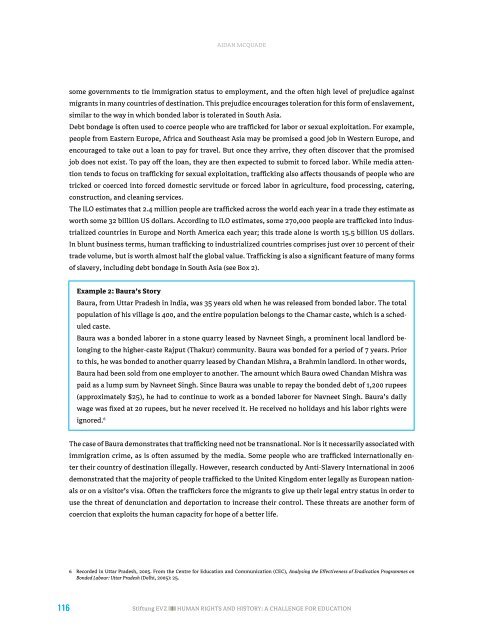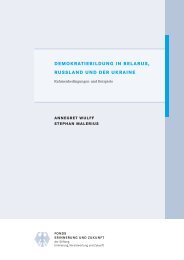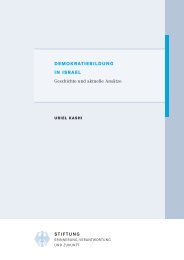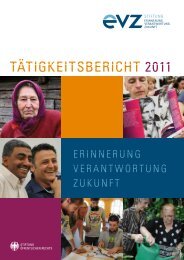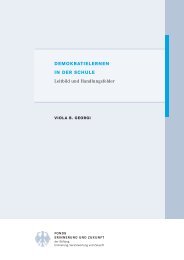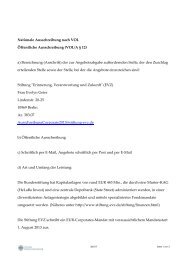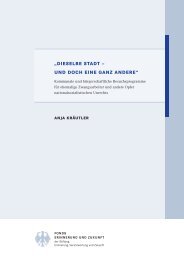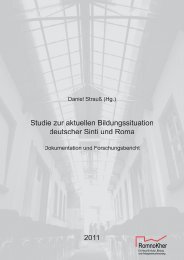chapter 2 - Stiftung "Erinnerung, Verantwortung und Zukunft"
chapter 2 - Stiftung "Erinnerung, Verantwortung und Zukunft"
chapter 2 - Stiftung "Erinnerung, Verantwortung und Zukunft"
Create successful ePaper yourself
Turn your PDF publications into a flip-book with our unique Google optimized e-Paper software.
Aidan McQuade<br />
some governments to tie immigration status to employment, and the often high level of prejudice against<br />
migrants in many countries of destination. This prejudice encourages toleration for this form of enslavement,<br />
similar to the way in which bonded labor is tolerated in South Asia.<br />
Debt bondage is often used to coerce people who are trafficked for labor or sexual exploitation. For example,<br />
people from Eastern Europe, Africa and Southeast Asia may be promised a good job in Western Europe, and<br />
encouraged to take out a loan to pay for travel. But once they arrive, they often discover that the promised<br />
job does not exist. To pay off the loan, they are then expected to submit to forced labor. While media attention<br />
tends to focus on trafficking for sexual exploitation, trafficking also affects thousands of people who are<br />
tricked or coerced into forced domestic servitude or forced labor in agriculture, food processing, catering,<br />
construction, and cleaning services.<br />
The ILO estimates that 2.4 million people are trafficked across the world each year in a trade they estimate as<br />
worth some 32 billion US dollars. According to ILO estimates, some 270,000 people are trafficked into industrialized<br />
countries in Europe and North America each year; this trade alone is worth 15.5 billion US dollars.<br />
In blunt business terms, human trafficking to industrialized countries comprises just over 10 percent of their<br />
trade volume, but is worth almost half the global value. Trafficking is also a significant feature of many forms<br />
of slavery, including debt bondage in South Asia (see Box 2).<br />
Example 2: Baura’s Story<br />
Baura, from Uttar Pradesh in India, was 35 years old when he was released from bonded labor. The total<br />
population of his village is 400, and the entire population belongs to the Chamar caste, which is a scheduled<br />
caste.<br />
Baura was a bonded laborer in a stone quarry leased by Navneet Singh, a prominent local landlord belonging<br />
to the higher-caste Rajput (Thakur) community. Baura was bonded for a period of 7 years. Prior<br />
to this, he was bonded to another quarry leased by Chandan Mishra, a Brahmin landlord. In other words,<br />
Baura had been sold from one employer to another. The amount which Baura owed Chandan Mishra was<br />
paid as a lump sum by Navneet Singh. Since Baura was unable to repay the bonded debt of 1,200 rupees<br />
(approximately $25), he had to continue to work as a bonded laborer for Navneet Singh. Baura’s daily<br />
wage was fixed at 20 rupees, but he never received it. He received no holidays and his labor rights were<br />
ignored. 6<br />
The case of Baura demonstrates that trafficking need not be transnational. Nor is it necessarily associated with<br />
immigration crime, as is often assumed by the media. Some people who are trafficked internationally enter<br />
their country of destination illegally. However, research conducted by Anti-Slavery International in 2006<br />
demonstrated that the majority of people trafficked to the United Kingdom enter legally as European nationals<br />
or on a visitor’s visa. Often the traffickers force the migrants to give up their legal entry status in order to<br />
use the threat of denunciation and deportation to increase their control. These threats are another form of<br />
coercion that exploits the human capacity for hope of a better life.<br />
6 Recorded in Uttar Pradesh, 2005. From the Centre for Education and Communication (CEC), Analysing the Effectiveness of Eradication Programmes on<br />
Bonded Labour: Uttar Pradesh (Delhi, 2005): 25.<br />
116<br />
<strong>Stiftung</strong> EVZ<br />
HUMAN RIGHTS AND HISTORY: A CHALLENGE FOR EDUCATION


